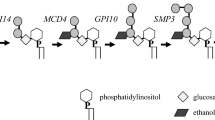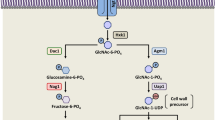Abstract
Structural studies of cell wall components of the pathogenic yeast Candida albicans revealed a family of genes involved in beta-mannosyltransferase associated with the addition of beta-mannose to the acid-labile fraction of cell wall phosphopeptidomannan. Despite the importance of beta-1, 2-oligomannosides in virulence, the gene expression pattern of this family during hyphae transition have not been identified in C. albicans. We investigated using RT-qPCR whether genes encoding beta-1, 2-mannosylation of glycans and putative cell wall proteins are expressed during hyphae induction. Here, we identify four out of nine putative genes encoding beta-1, 2-mannosylation of glycans, BMT2, BMT4, BMT5, and BMT6 were downregulated during 30, 60, and 180 min of hyphae transition. We also observed that expression of Candida putative GPI-anchored protein coding genes PGA6, PGA19, PGA54, PGA56, PGA58, PGA59, and PGA13 were upregulated after 60 min of hyphae transition, while the levels of expression of these genes showed moderately changes during 15 and 180 min of hyphae transition. In either case, the involvement of these genes in hyphal growth makes them putative targets for new antifungal drugs aimed at inhibiting hyphae formation in C. albicans.


Similar content being viewed by others
References
Abrams BB, Hanel H, Hoehler T (1991) Ciclopirox olamine: a hydroxypyridone antifungal agent. Clin Dermatol 9:471–477
Bensen ES, Filler SG, Berman J (2002) A forkhead transcription factor is important for true hyphal as well as yeast morphogenesis in Candida albicans. Eukaryot Cell 1:787–798
Castillo L, Martinez AI, Garcera A, Garcia-Martinez J, Ruiz-Herrera J, Valentin E, Sentandreu R (2006) Genomic response programs of Candida albicans following protoplasting and regeneration. Fungal Genet Biol 43:124–134
De Groot PW, de Boer AD, Cunningham J, Dekker HL, de Jong L, Hellingwerf KJ, de Koster C, Klis FM (2004) Proteomic analysis of Candida albicans cell walls reveals covalently bound carbohydrate-active enzymes and adhesins. Eukaryot Cell 3:955–965
De Groot PW, Hellingwerf KJ, Klis FM (2003) Genome-wide identification of fungal GPI proteins. Yeast 20:781–796
Elson SL, Noble SM, Solis NV, Filler SG, Johnson AD (2009) An RNA transport system in Candida albicans regulates hyphal morphology and invasive growth. PLoS Genet 5:e1000664
Felk A, Kretschmar M, Albrecht A, Schaller M, Beinhauer S, Nichterlein T, Sanglard D, Korting HC, Schafer W, Hube B (2002) Candida albicans hyphal formation and the expression of the Efg1-regulated proteinases Sap4 to Sap6 are required for the invasion of parenchymal organs. Infect Immun 70:3689–3700
Fonzi WA, Irwin MY (1993) Isogenic strain construction and gene mapping in Candida albicans. Genetics 134:717–728
Ghalehnoo ZR, Rashki A, Najimi M, Dominguez A (2010) The role of diclofenac sodium in the dimorphic transition in Candida albicans. Microb Pathog 48:110–115
Harcus D, Nantel A, Marcil A, Rigby T, Whiteway M (2004) Transcription profiling of cyclic AMP signaling in Candida albicans. Mol Biol Cell 15:4490–4499
Kniemeyer O, Schmidt AD, Vodisch M, Wartenberg D, Brakhage AA (2011) Identification of virulence determinants of the human pathogenic fungi Aspergillus fumigatus and Candida albicans by proteomics. Int J Med Microbiol 301(5):368–377
Lermann U, Morschhauser J (2008) Secreted aspartic proteases are not required for invasion of reconstituted human epithelia by Candida albicans. Microbiology 154:3281–3295
Liu TT, Lee RE, Barker KS, Lee RE, Wei L, Homayouni R, Rogers PD (2005) Genome-wide expression profiling of the response to azole, polyene, echinocandin, and pyrimidine antifungal agents in Candida albicans. Antimicrob Agents Chemother 49:2226–2236
Lo HJ, Kohler JR, DiDomenico B, Loebenberg D, Cacciapuoti A, Fink GR (1997) Nonfilamentous C. albicans mutants are avirulent. Cell 90:939–949
Losberger C, Ernst JF (1989) Sequence of the Candida albicans gene encoding actin. Nucleic Acids Res 17:9488
Mille C, Bobrowicz P, Trinel PA, Li H, Maes E, Guerardel Y, Fradin C, Martinez-Esparza M, Davidson RC, Janbon G, Poulain D, Wildt S (2008) Identification of a new family of genes involved in beta-1, 2-mannosylation of glycans in Pichia pastoris, and Candida albicans. J Biol Chem 283:9724–9736
Mio T, Adachi-Shimizu M, Tachibana Y, Tabuchi H, Inoue SB, Yabe T, Yamada-Okabe T, Arisawa M, Watanabe T, Yamada-Okabe H (1997) Cloning of the Candida albicans homolog of Saccharomyces cerevisiae GSC1/FKS1 and its involvement in beta-1, 3-glucan synthesis. J Bacteriol 179:4096–4105
Nantel A, Dignard D, Bachewich C, Harcus D, Marcil A, Bouin AP, Sensen CW, Hogues H, van het Hoog M, Gordon P, Rigby T, Benoit F, Tessier DC, Thomas DY, Whiteway M (2002) Transcription profiling of Candida albicans cells undergoing the yeast-to-hyphal transition. Mol Biol Cell 13:3452–3465
Ramanan N, Wang Y (2000) A high-affinity iron permease essential for Candida albicans virulence. Science 288:1062–1064
Rashki A, Ghalehnoo ZR, Dominguez A (2012) The early response of Candida albicans filament induction is coupled with wholesale expression of the translation machinery. Comp Clin Pathol 21:1533–1545
Sandovsky-Losica H, Chauhan N, Calderone R, Segal E (2006) Gene transcription studies of Candida albicans following infection of HEp2 epithelial cells. Med Mycol 44:329–334
Shen J, Cowen LE, Griffin AM, Chan L, Kohler JR (2008) The Candida albicans pescadillo homolog is required for normal hyphal-to-yeast morphogenesis and yeast proliferation. Proc Natl Acad Sci U S A 105:20918–20923
Sherman F (2005) The importance of mutation, then and now: studies with yeast cytochrome c. Mutat Res 589:1–16
Shorr AF, Gupta V, Sun X, Johannes RS, Spalding J, Tabak YP (2009) Burden of early-onset candidemia: analysis of culture-positive bloodstream infections from a large U.S. database. Crit Care Med 37:2519–2526, quiz 2535
Sudbery P, Gow N, Berman J (2004) The distinct morphogenic states of Candida albicans. Trends Microbiol 12:317–324
Terashima H, Yabuki N, Arisawa M, Hamada K, Kitada K (2000) Upregulation of genes encoding glycosylphosphatidylinositol (GPI)-attached proteins in response to cell wall damage caused by disruption of FKS1 in Saccharomyces cerevisiae. Mol Gen Genet 264:64–74
Trofa D, Gacser A, Nosanchuk JD (2008) Candida parapsilosis, an emerging fungal pathogen. Clin Microbiol Rev 21:606–625
Wisplinghoff H, Bischoff T, Tallent SM, Seifert H, Wenzel RP, Edmond MB (2004) Nosocomial bloodstream infections in US hospitals: analysis of 24,179 cases from a prospective nationwide surveillance study. Clin Infect Dis 39:309–317
Zaoutis TE, Argon J, Chu J, Berlin JA, Walsh TJ, Feudtner C (2005) The epidemiology and attributable outcomes of candidemia in adults and children hospitalized in the United States: a propensity analysis. Clin Infect Dis 41:1232–1239
Author information
Authors and Affiliations
Corresponding author
Rights and permissions
About this article
Cite this article
Rashki, A., Rashki Ghalehnoo, Z. & Rashki Ghalehnoo, M. Functional analysis of genes involved in beta-1, 2-Mannosylation of glycans and putative cell wall proteins in Candida albicans during hyphae transition. Comp Clin Pathol 23, 917–921 (2014). https://doi.org/10.1007/s00580-013-1713-9
Received:
Accepted:
Published:
Issue Date:
DOI: https://doi.org/10.1007/s00580-013-1713-9




